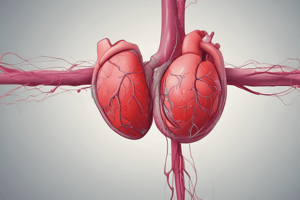Podcast
Questions and Answers
What is the embryological origin of the interatrial (IA) septum?
What is the embryological origin of the interatrial (IA) septum?
The IA septum is formed by the septum primum and septum secundum.
What are some possible causes of the failure of proper development of the septum secundum or failure of closure of the ostium primum?
What are some possible causes of the failure of proper development of the septum secundum or failure of closure of the ostium primum?
Some possible causes include chromosomal abnormalities, prematurity, low birth weight, prostaglandins, high altitude and low atmospheric oxygen tension, and hypoxia.
What is the most common congenital heart defect?
What is the most common congenital heart defect?
The most common congenital heart defect is a ventricular septal defect (VSD).
What is the embryological origin of the ventricular (IV) septum?
What is the embryological origin of the ventricular (IV) septum?
What are the possible causes of a ventricular septal defect (VSD)?
What are the possible causes of a ventricular septal defect (VSD)?
What is the tetralogy of Fallot?
What is the tetralogy of Fallot?
What is the embryological cause of the tetralogy of Fallot?
What is the embryological cause of the tetralogy of Fallot?
What is the embryological cause of transposition of the great vessels?
What is the embryological cause of transposition of the great vessels?
What is coarctation of the aorta?
What is coarctation of the aorta?
What are some possible causes of coarctation of the aorta?
What are some possible causes of coarctation of the aorta?
Describe the role of placenta in drug distribution.
Describe the role of placenta in drug distribution.
What are the different fluid compartments in the body?
What are the different fluid compartments in the body?
What is the volume of distribution?
What is the volume of distribution?
Explain the single compartment model of drug distribution.
Explain the single compartment model of drug distribution.
How does the volume of distribution (Vd) affect a drug's half-life?
How does the volume of distribution (Vd) affect a drug's half-life?
What is drug distribution?
What is drug distribution?
What factors affect drug distribution?
What factors affect drug distribution?
What is the role of cardiac output in drug distribution?
What is the role of cardiac output in drug distribution?
What is the significance of albumin binding in drug distribution?
What is the significance of albumin binding in drug distribution?
What are the characteristics of drugs that may pass the blood-brain barrier?
What are the characteristics of drugs that may pass the blood-brain barrier?



